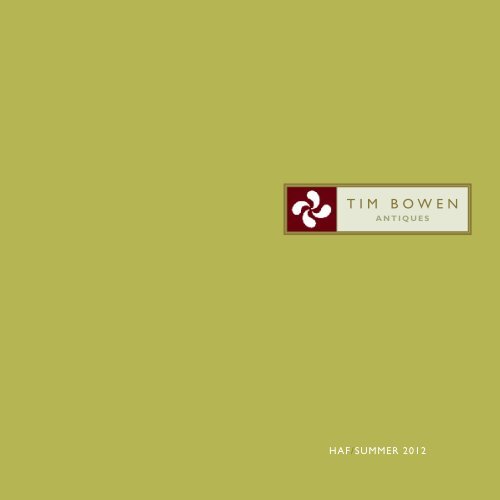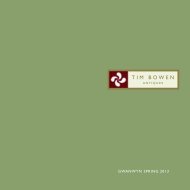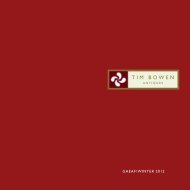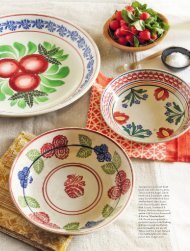Tim Bowen Antiques
Tim Bowen Antiques
Tim Bowen Antiques
Create successful ePaper yourself
Turn your PDF publications into a flip-book with our unique Google optimized e-Paper software.
T I M B O W E N<br />
A N T I Q U E S<br />
HAF/SUMMER 2012
Eleni rydym yn cynnwys cadair cefn ffyn eitem: 18 hardd a chyfforddus<br />
tu hwnt, gan Chris Williams, crefftwr o Sir Gaerfyrddin, sydd yn<br />
dangos parhad y traddodiad Cymreig o’r grefft hynafol hon. Mae’r<br />
pren staes eitem: 14 yn arbennig o brin a phrydferth. Byddwch wrth<br />
eich bodd gyda’r llwy garu fechan eitem: 7, un o’r lleiaf i ni ei gweld<br />
erioed. Yn y llun ‘The Kilmeny’ gan John Henry Mohrmann eitem: 4<br />
cawsom ein swyno gan ei steil hynod yn ogystal a’i hanes a’i gysylltiad<br />
gyda Chymru. Mae’r sgiw fechan eitem: 3 yn hardd a chyfforddus<br />
hefyd. Gobeithio bod yma rywbeth i’ch boddhau a’ch diddori.<br />
Arddangosfa Haf 2012<br />
2 Mehefin – 9 Mehefin<br />
10 y bore – 5 yr hwyr pob dydd<br />
Mae’r eitemau ar werth yn union<br />
Oriel Gyferbyn Ivy House Glan y Fferi Sir Gar SA17 5SS
<strong>Tim</strong> <strong>Bowen</strong> <strong>Antiques</strong><br />
Summer Exhibition 2012<br />
This collection is, once again, a celebration of the best of country<br />
furniture and folk art. For 2012, we have included a stick chair<br />
item: 18 by Carmarthenshire based Chris Williams, whose chairs are<br />
beautiful, extremely comfortable and demonstrate the continuity of<br />
an important Welsh tradition. The stay busk item: 14 is a particularly<br />
rare and beautiful thing. The tiny lovespoon item: 7 is one of the<br />
smallest, but no less delightful that we have seen. The painting,<br />
The Kilmeny by John Henry Mohrmann item: 4 we loved for its quirky<br />
style as well as its history and connection to Wales. The small Welsh<br />
oak settle item: 3 is beautiful and comfortable too. We hope there is<br />
something to delight and interest you.<br />
Summer Exhibition 2012<br />
2 June – 9 June<br />
10.00am – 5.00pm every day<br />
All items are for sale immediately<br />
Gallery Opposite Ivy House Ferryside Carmarthenshire SA17 5SS
<strong>Tim</strong> <strong>Bowen</strong> <strong>Antiques</strong><br />
Summer Exhibition 2012<br />
1. Small Welsh oak linen press/<br />
Cwpwrdd pres bychan derw<br />
It has many interesting details, including<br />
panelled sides and mahogany frieze below<br />
the cornice, applied, turned and carved<br />
mouldings, with mahogany inlay below the<br />
door and also the makers pencil inscription.<br />
“John Davies, carpenter, Cefn Coed 1877”<br />
Cardiganshire<br />
50 1 /2” wide x 68 1 /4” high x 20” deep
2. Farmhouse table/Bwrdd ty^ fferm<br />
A beautiful sycamore top on an oak base. Sycamore is a wood that is<br />
associated with the dairy industry as it does not leave a taste to the<br />
food which is prepared on it. This table probably stood under a window<br />
to maximise the natural light whilst making butter. However its height<br />
allows it to make a comfortable kitchen dining table<br />
West Wales circa 1850<br />
75” long x 31” wide x 31” overall height (22” knee height)
<strong>Tim</strong> <strong>Bowen</strong> <strong>Antiques</strong><br />
Summer Exhibition 2012<br />
3. Rare small Welsh settle/<br />
Sgiw fechan brin<br />
Made from beautifully figured oak and<br />
unusually small, with a lift up box seat<br />
Capel Hendre Llandybie,<br />
Carmarthenshire circa 1780<br />
36 1 /2” wide x 47” high x 26” deep<br />
Illustrated in Welsh Furniture 1250-1950 by<br />
Richard Bebb, Saer Books 2007 vol I page 63
4.The Kilmeny – signed J H Mohrmann dated 1901/Y Kilmeny – gan John Henry Mohrmann 1901<br />
Oil on canvas by John Henry Mohrmann<br />
44” wide x 28 1 /2 high (including frame)<br />
The Kilmeny was captained by Master William Jones (1856-1923) from its launch. It regularly sailed from Aberaeron, with its Welsh captain and<br />
crew. Captain Jones was said to have once tried to sail around Cape Horn but finding the weather so bad, he sailed half way round the world to<br />
reach his destination. Master John Davies of Angorfa, Aberaeron was the next captain of the ship who also sailed many times around Cape Horn<br />
and was believed to have fought pirates in the South China seas. The artist John Henry Mohrmann (1857-1916) was a prolific and prestigious<br />
maritime painter based in Antwerp. He used photography as a tool in his work and it is possible that this painting of the Kilmeny is from a<br />
photograph. A particular feature of his work, is that the ship is often shown driving a little inclined towards the viewer, thereby showing more<br />
of the ship’s detail<br />
See: Gathering the Jewels website – www.gtj.org.uk/en/small/item/GTJ08041/ and www.plimsoll.org
<strong>Tim</strong> <strong>Bowen</strong> <strong>Antiques</strong><br />
Summer Exhibition 2012<br />
5. Small oak cupboard/linen press/<br />
Cwpwrdd pres bychan derw<br />
With a carved frieze, dentil moulded cornice<br />
and reeded quarter columns. The contrasting<br />
colours on this cupboard may confirm the<br />
tradition of using timber that was grown,<br />
cut and worked, on the land of whoever<br />
commissioned the item<br />
Cardiganshire circa 1820<br />
54 1 /4” wide x 56 1 /2” high x 19” deep<br />
See Welsh Furniture 1250-1950 by Richard<br />
Bebb, Saer Books 2007 vol 2 pages 153 and<br />
212 for references to this tradition
6. Coffor bach<br />
A classic example of a West Wales coffor bach. These miniature coffers<br />
seem to have been peculiar to Wales. Traditionally thought to have been<br />
given as a wedding gift or as part of a dowry. They often have great<br />
sentiment having been handed down through families<br />
Oak<br />
Carmarthenshire/Cardiganshire circa 1790<br />
(with old repairs)<br />
24 1 /2” wide x 17 1 /2” high x 14 1 /4” deep
<strong>Tim</strong> <strong>Bowen</strong> <strong>Antiques</strong><br />
Summer Exhibition 2012<br />
7. Small love spoon/<br />
Llwy garu fechan<br />
A rare sized love spoon with delicately<br />
carved and pierced decoration<br />
Beech<br />
Welsh circa 1880<br />
5 1 /2” high x 1” wide x 1 /2” deep<br />
(shown actual size)
8. Set of four chairs/Set o bedair cadair<br />
With elaborate detail and rich patina<br />
Oak<br />
Montgomeryshire circa 1840<br />
13 1 /2” wide x 35 1 /2” high x 15” deep
<strong>Tim</strong> <strong>Bowen</strong> <strong>Antiques</strong><br />
Summer Exhibition 2012<br />
9. Oak hanging corner cupboard/<br />
Cwpwrdd cornel crog o dderw<br />
The interior with two shaped shelves.<br />
Wonderful rich patina<br />
West Wales circa 1760<br />
33” wide x 40 1 /2” high x 16 1 /4” deep
10.Welsh oak press cupboard/<br />
Cwpwrdd pres o dderw Cymreig<br />
The interior of the cupboard has a single<br />
shelf, but with further storage behind the top<br />
row of drawers of the base, which are false,<br />
and five working drawers below<br />
Mid Wales circa 1800<br />
52” wide x 72 3 /4” high x 20” deep
<strong>Tim</strong> <strong>Bowen</strong> <strong>Antiques</strong><br />
Summer Exhibition 2012<br />
11. Rare Welsh oak desk box/Blwch prin o dderw Cymreig<br />
The carved roundels to the front are associated with furniture from<br />
Montgomeryshire and Radnorshire. Carved with various initials and dated 1668<br />
24 1 /2” wide x 12” high x 19” deep<br />
See Welsh Furniture 1250-1950 by Richard Bebb, Saer Books 2007 vol 1 page 146.<br />
Item 234 oak chest with similar roundels also page 295 item 498 a miniature<br />
chest. Oak Furniture by Victor Chinnery, <strong>Antiques</strong> Collectors Club 1979 page 330<br />
a mural cupboard
12.Welsh arm chair/<br />
Cadair freichiau Cymreig<br />
A wonderful and rare panelled back arm<br />
chair with elaborate finials and top rail with<br />
cabriole legs<br />
Oak<br />
Welsh possibly Montgomeryshire circa 1730<br />
20” wide x 50” high x 19” deep
<strong>Tim</strong> <strong>Bowen</strong> <strong>Antiques</strong><br />
Summer Exhibition 2012<br />
13. Elm cricket table/<br />
Bwrdd criced o lwyfen<br />
Made from wonderfully figured timber<br />
Wales/West Country circa 1800<br />
26 1 /2” diameter x 27 3 /4” high
14. Stay busk/Pren staes<br />
The front with carved intertwined hearts,<br />
flowers and roundels with traces of original<br />
red paint. The reverse carved with initials<br />
“IAM WM IEB” and dated 1799<br />
Fruitwood<br />
Welsh<br />
12” long x 1 1 /4” wide x 1 /2” deep<br />
A stay busk was used in ladies corsets and<br />
were often carved and given as love tokens<br />
Illustrated in Treen and other turned woodware<br />
for collectors by Jane Toller, David & Charles<br />
1975 plate 16 page 105
<strong>Tim</strong> <strong>Bowen</strong> <strong>Antiques</strong><br />
Summer Exhibition 2012<br />
15. Rare Welsh demi – lune table/Bwrdd hanner cylch prin Cymreig<br />
Oak with holly, bog oak and mahogany inlay decoration to the top edge,<br />
the frieze and top of the legs<br />
Carmarthenshire circa 1820<br />
48” wide x 29 1 /2” high x 24 1 /4” deep
16. Oak desk/Desg dderw<br />
With a shaped top gallery above a writing<br />
slope with single drawer. The interior fitted<br />
with small drawers and pigeon holes<br />
West Wales circa 1790<br />
31” wide x 40 3 /4” high x 18 1 /2” deep
<strong>Tim</strong> <strong>Bowen</strong> <strong>Antiques</strong><br />
Summer Exhibition 2012<br />
17. Small stick chair/<br />
Cadair cefn ffyn bychan<br />
Ash with traces of original finish<br />
Cardiganshire circa 1800<br />
15 3 /4” wide x 31” high x 11” deep
18.Welsh stick chair/<br />
Cadair cefn ffyn Cymreig<br />
Ash<br />
Carmarthenshire 2012<br />
38 1 /2” wide x 72 1 /2” high x 19” deep<br />
Chris Williams is a skilled artist and craftsman,<br />
based in Carmarthenshire. Like his mentor,<br />
the late John Brown, author of the Welsh Stick<br />
Chairs (1990 Stobart Davies), Chris was<br />
inspired by the craft of the Welsh stick chair<br />
makers, whose methods were largely unchanged<br />
since the 13th century. His chairs are made<br />
entirely with the use of traditional hand tools<br />
and made from oak, elm and ash sourced in<br />
Wales, where they are sought-after and<br />
collected. Here, in a move away from the<br />
modern desire to ‘see the wood’ and thereby<br />
the usual French polish or waxed finish, he has<br />
finished this chair with traditional milk paint.<br />
Because of this, the eye is not distracted by<br />
the grain of the wood and concentrates on<br />
the form of the chair
<strong>Tim</strong> <strong>Bowen</strong> <strong>Antiques</strong><br />
Summer Exhibition 2012<br />
19. Set of three ‘Country Chippendale’ chairs/<br />
Set o dair cadair<br />
With an elaborate carved top-rail and gothic designed back splat<br />
Elm<br />
Welsh circa 1780<br />
18 1 /4” wide x 38” high x 16” deep
20. Oak pedestal table/<br />
Bwrdd ungoes o dderw<br />
The top made from beautifully figured timber,<br />
on a bold pedestal and cabriole legs<br />
Mid Wales circa 1780<br />
35 1 /2” diameter x 27” high
<strong>Tim</strong> <strong>Bowen</strong> <strong>Antiques</strong><br />
Summer Exhibition 2012<br />
21. Rushlight and candle holder/<br />
Canhwyllarn frwyn<br />
Wrought iron and unusually large size<br />
North Wales circa 1800<br />
15” high x 7 1 /4” diameter<br />
The round base is usually associated with Irish<br />
rushlight holders but they are occasionally found<br />
in North Wales, this holder was probably from<br />
Snowdonia
22. Oak chest/Cist dderw<br />
A boarded chest with channel moulded carving to the front and lid.<br />
The hinges and lock are old replacements<br />
Welsh/English circa 1640<br />
45 1 /4” wide x 21 1 /2” high x 13 1 /2” deep
<strong>Tim</strong> <strong>Bowen</strong> <strong>Antiques</strong><br />
Summer Exhibition 2012<br />
23. Pedestal table/Bwrdd ungoes<br />
A walnut top with a birdcage type fixing<br />
enabling the top to tilt and turn, on a<br />
turned oak ‘gun barrel’ pedestal and walnut<br />
cabriole legs<br />
Welsh circa 1740<br />
23” diameter x 27 1 /4” high
24. Love spoon/Llwy garu<br />
With pierced hearts, pin-wheel and<br />
chip carved decoration<br />
Sycamore<br />
Welsh circa 1880<br />
11 1 /2” high x 2 3 /4” wide x 1 /2 deep
<strong>Tim</strong> <strong>Bowen</strong> <strong>Antiques</strong><br />
Summer Exhibition 2012<br />
25. Oat cake peel/<br />
Rhawlech i droi bara ceirch<br />
An elaborately carved small peel with initials<br />
“MH” and date 17(80) and “Tyn coed”<br />
possibly the house name<br />
Beech<br />
West Wales 1780<br />
12 1 /2” high x 3 3 /4” wide
26. Oak chair/Cadair dderw<br />
With an elaborate arched top rail which has<br />
pierced, carved and punched decoration.<br />
The base with finely turned legs and<br />
stretchers and carved front feet<br />
North Wales circa 1700<br />
18 1 /2” wide x 45 1 /2” high x 16 1 /2” deep
<strong>Tim</strong> <strong>Bowen</strong> <strong>Antiques</strong><br />
Summer Exhibition 2012<br />
27. Oak hanging tray/Hambwrdd crog derw<br />
A two tier tray possibly used for storing candles<br />
Mid Wales circa 1760<br />
12 3 /4” wide x 15 3 /4” high x 5 1 /4” deep
28.Tinder box/Blwch tân<br />
The interior is divided into two<br />
compartments, one for storing a flint, steel<br />
striker and tinder, the second for holding<br />
the tinder whilst it was sparked and lit<br />
Walnut (some old repairs)<br />
Welsh circa 1750<br />
4 3 /4” wide x 11 3 /4” high x 3” deep
<strong>Tim</strong> <strong>Bowen</strong> <strong>Antiques</strong><br />
Summer Exhibition 2012<br />
29. Oak Cricket table/<br />
Bwrdd criced derw<br />
A lovely classic Welsh table<br />
West Wales circa 1800<br />
26 1 /4” diameter x 28 1 /2” high<br />
Cricket tables were found in all parts<br />
of Wales, throughout the 18th, 19th<br />
and early 20th century. The three legs<br />
always ensured stability on uneven<br />
floor
30. Small oak table/<br />
Bwrdd bychan derw<br />
With simple carved channel moulding<br />
to the legs and stretchers<br />
Welsh circa 1720<br />
27 1 /2” wide x 25” high x 19 1 /2” deep
<strong>Tim</strong> <strong>Bowen</strong> <strong>Antiques</strong><br />
Summer Exhibition 2012<br />
31. Small oak stool/Stôl fechan dderw<br />
With pierced top and shaped sides and legs<br />
Welsh circa 1880<br />
12” wide x 8 1 /4” high x 6 3 /4” deep
32. Small oak box/Blwch bychan derw<br />
With box-wood escutcheon<br />
Carmarthenshire circa 1790<br />
9 1 /2” wide x 7” high x 6” deep
<strong>Tim</strong> <strong>Bowen</strong> <strong>Antiques</strong><br />
Summer Exhibition 2012<br />
33. Siôn Catrin –<br />
The Bell Ringer at Gwydir Chapel/<br />
Siôn Catrin – Clochydd Capel<br />
Castell Gwydr<br />
Oil on board signed R Roberts July 1888<br />
in original frame<br />
16 3 /4 high x 13 1 /2 wide<br />
Siôn Catrin or Jack Hughes was a Llanrwst<br />
eccentric who was painted from a photograph<br />
taken by John Thomas, a prolific photographer<br />
who travelled throughout Wales in the late<br />
19th century<br />
See Welsh Way of Life John Thomas<br />
photographer by Iwan Meical Jones<br />
published by Y Llolfa 2008<br />
Provenance lot 212 a sale of the contents<br />
of Gwydir Castle Llanrwst Gwynedd 10th &<br />
11th May 1982 by Jackson Stops & Staff
34. Knitting sheath/<br />
Pren i ddal gweillen weu<br />
Bog oak with the needle hole capped in<br />
bone and carved with a heart and acorn<br />
Welsh circa 1890<br />
6 1 /4” long x 3 /4” wide x 3 /4” deep<br />
“The use of the stick ‘sheath’ was to<br />
support a needle to work from during the<br />
process of knitting and for this purpose it<br />
had a hole in the end to receive the<br />
needle.”<br />
Guide to the collection of Welsh<br />
Bygones, Iorwerth Peate – National<br />
Museum of Wales 1927
<strong>Tim</strong> <strong>Bowen</strong> <strong>Antiques</strong><br />
Summer Exhibition 2012<br />
35.Table top coffor bach/Coffor bach pen bwrdd<br />
Oak coffor bach with initials “EW”. The initials and decoration to the<br />
drawers and front has been created by inlaying bog oak dowels into<br />
the surface<br />
Carmarthenshire circa 1780<br />
13 1 /2” wide x 9 3 /4” high x 8 1 /4” deep<br />
See Welsh Furniture 1250-1950 by Richard Bebb, Saer Books 2007<br />
vol 2 page 75 for another coffor bach with similar decoration
This catalogue is designed, photographed and printed in Wales<br />
by www.nb-design.com and www.kiranridley.com
<strong>Tim</strong> <strong>Bowen</strong> <strong>Antiques</strong><br />
Gallery Opposite Ivy House Ferryside Carmarthenshire SA17 5SS<br />
t: +44 (0)1267 267 122 e: info@timbowenantiques.co.uk<br />
w: www.timbowenantiques.co.uk





